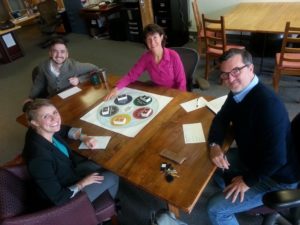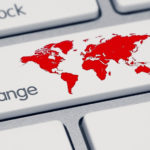Executive Summary
Authentic Leadership – History

Our past leadership models were rooted in a hierarchy and capitalistic mindset with a win, lose view – the survival of the fittest. Gaining more market share was the motivating force, often to the detriment of other indicators. Employees looked to their leaders for direction, at times as heroes, and masculine energy was more predominant.
Our old conditioning for “power over” leadership stems from numerous sources, including our educational systems where we were taught to follow. This mindset enabled a workforce to remain more consistent and stay in positions on average of 7.5 years; often motivated from a sense of loyalty and sometimes, fear.
Rewards were given based on expected performance and contingent rewards. Errors and shortcomings were communicated based on these specific goals. This is referred to as “transactional leadership,” an exchange, where each party does something for the other, a give and take.
In the eighties and nineties, a number of thought leaders including Peter Senge, Peter Drucker, Joel Barker, and others initiated an empowered movement. Dan Pink summarizes the three main drivers of employees as 1) autonomy, 2) purpose and 3) mastery. As people woke up to their creative energy and became more empowered, the complex systems of organizations split into other systems.
As a result, turnover has become a more consistent part of our work environment. More employees resign from corporations and are only staying on average of 1.5 years. A surge toward entrepreneurialism continues to grow. Now, nearly half the workforce are independent freelancers.
In the meantime, technology has grown significantly bringing efficiencies and easier access to broader opportunities and a global marketplace. At the same time, technology also contributes to feelings of overwhelm and chaos. Our workforce is primarily expected to be “on” and available to the demands of clients around the clock. Technology tends to take us out of our bodies and we often lose our connection with our innate, natural wisdom.
As communication changes are impacted by technology, our brains are rewiring. The dawn of new leadership is rising as generations adapt to the times. Millennials appear to be more creative and team-based leaders and less demanding of money and status.
Women as well, are stepping into leadership positions in many arenas and launching a plethora of new businesses. Over the last few years, the “me too” movement has accelerated the need to broaden women’s financial impact and transform our collective consciousness. Although biases against women in corporate leadership positions have decreased dramatically over the last half-decade, there remain subtle perspectives that continue to undermine and limit women’s access to power.
Over the last twenty years, in response to all the stress, mindfulness has developed as a necessary movement for sanity in our current day. In the west, it was developed as a stress-reduction technique and primarily practiced outside of work. As more people are finding yoga, somatic practices, and other mindfulness practices, they continue to build awareness for the wide positive influence these practices have in supporting our emotional, physical, spiritual and mental faculties.

Authentic Leadership – Current Position
The future is unstable as our workforce changes. For many of us, the normal way of engaging is met with resistance. Our diverse workforce landscape continues to develop with cultural differences and generational changes requiring new ways to fill the communication gaps. In March 2019, Harvard Business Review reported that the number one reason for lack of engagement is poor leadership.
Overall, we are living in transformational times. Our inner and outer ecosystems are out of balance. Stress and trauma have become all too common, and confusion is pulling us in many directions. Our old organizational models do not support the current movement toward sustainable ecosystems and prosperity for all.
In fact, our current systemic structures (healthcare, education, financial…) are causing stress, distraction, suppression, injustices, and even destruction. They contribute to the detriment and destruction of our inner and outer ecosystems and continue to pull upon one’s worth, and ability to effectively collaborate and grow.
As systems break-down and changes continue to speed up, reactivity is becoming an automatic response. Reactive communication and decision making does not generally come from wisdom and often contributes to the chaos and trauma. How do we lead today and engage resilience within our organizations? How do we not only respond to change but create change?
Currently, we know a great deal about what leaders do and how they do it. But we know very little about the inner place, the source from which they operate. New thought leaders are pointing to the whole being with discussions on emotional and somatic intelligence, spiritual wisdom and our interconnected natures. A few such leaders include Echkart Tolle, Brene Brown, and Otto Scharmer. Eckhart Tolle, Thich Nhat Hanh, and other eastern monks are pointing to mindfulness, the power of presence and releasing the ego. Brene Brown speaks about the importance of vulnerability and the influence of shame and guilt.
As we become more mindful, other somatic organizations including the Heart Math Institute and brain-based organizations are explaining the importance of nutrition and somatic care for our bodies. Eastern approaches continue to influence our experiential learning with qigong, yoga, and constellations for systemic understandings.
Otto Scharmer from MIT summarizes the call for leadership as follows: “We are living in a time of massive institutional failure, collectively creating results that nobody wants. Climate change. Hunger. Poverty. Violence. Terrorism. Destruction of communities, nature, life nature, life—the foundations of our social, economic, ecological, and spiritual well-being. This time calls for a new consciousness and a new collective leadership capacity to meet challenges in a more conscious, intentional, and strategic way.”
The point is new leadership is required to move beyond our current conditioning, to heal trauma and integrate emotional intelligence. Ecosystems need to be tended to for wholeness. We need to be inclusive. The realization for an integrated and balanced leadership style is dawning, requiring a balance in feminine and masculine energies. Learning to navigate with uncertainty, integrate body wisdom, emerge clarity from the formless, and rebuild from wholeness are necessary skills. Authentic, meaningful, engaging, co-creative leadership is required.
In contrast to transactional leadership, “transformational leadership” is emerging as a better solution. Transformational leadership comes from a new consciousness and inspires engagement. Transformational leaders authentically motivate from the inside-out and develop within themselves and those they lead a capacity to create the future of greater possibilities and move as one.

Authentic Leadership – Future Outlook
We need to prepare leaders for a different kind of future, one that will be constantly changing and increasingly interconnected, interdependent, and complex. Some things are coming to an end as old structures crumble. At the same time, new structures are rising up, some from the rubble.
A new workforce is emerging from our creatively empowered and autonomous workforce along with our global interconnection and developing social, emotional wisdom. As well, many in our current workforce will be displaced as technology, and in particular, Artificial Intelligence catapults us all into new dimensions.
As a result, leaders need to be masterful change agents in a world with new rules, new pressures and a new normal. According to MIT and Fritjof Capra on systems in the social sciences, we need to incorporate three aspects: the ecological, the social, and the spiritual. In eastern wisdom, this is referred to as three energies: earth, humanity, and heaven.
How do we do this? Leaders need to evolve their understanding of who they are, who we are and what we can create together. Through conscious evolution of individuals and organizations, we can address the root causes of systemic issues and locate the missing pieces in our three aspects, our three energies. We need to move beyond imbalances and develop new skills to see change and respond proactively.
Transformational change is possible by utilizing a framework that integrates the energy, actions, and awareness needed to “move as one”. We need to use a framework that integrates our ecological, social and spiritual divides and balances feminine and masculine energies for a whole system approach. This transforms people and organizations to grow organically and motivates employees from within. A whole-system approach moves us beyond our limited capacities and aligns us with our innate nature.
How do we do this? Authentic Leadership.
Moving as one means we include, ignite and co-create with all the elements for whole system change; our greater good. Each of us is a living, breathing and walking ecosystem, a movement of nature. When we move as one, we are in rhythm with our natural ecosystem. This changes from reacting to engaging and pollinating healthy ecosystems within ourselves, work, family, environment and community. It guides us to be nimble, flexible, responsive and authentic by redirecting attention from the exterior to the inner way of seeing.
People can be taught to move as one through experiential learning and authentic leadership. Authentic leadership begins by knowing yourself, being real with yourself from the purity of heart, and following your inner guidance. As one changes the quality of attention to an internal awareness it becomes easier to follow clear inspiration. Through alignment with your body, mind, heart, and spirit, one balances from within and comes from a place of peace, wisdom, and wholeness. To be authentic means we integrate the emotional, physical, mental and spiritual forces of our nature.
From this position, authentic leadership draws upon unique gifts to consciously rise up to meet what is next, clear the way forward, and respond in ways that transforms confusion. Authentic leaders can see the ecosystem in all living organisms and knows when one part is out of balance, all areas suffer; it impacts the whole.
As masterful change agents, authentic leaders facilitate others to move as one as individuals and together through co-creative conversations to emerge a greater future. They renew organizational culture by creating conditions and hosting environments to unleash the natural flow, and guiding others to their authentic selves knowing each person contributes to that culture.
Many of us have experienced healthy ecosystems where all people, entities, and elements are nourished and are working for the whole. It feels natural, harmonious and in-tune with our innate rhythm. It is easy to be in these healthy ecosystems that work well and help all participants prosper.
Personal Profile
Ms Delene is a Certified Learning Provider (CLP) at Appleton Greene and he has experience in management, production and human resources. She has achieved a Bachelor of Science in Computer Science and Mathematics with Business Emphasis. She has industry experience within the following sectors: Healthcare; Banking & Financial Services; Education; Advertising and Non-Profit & Charities. She has had commercial experience within the following countries: United States of America, or more specifically within the following cities: Twin Cities MN; Milwaukee WI; Omaha NE; Denver CO and Des Moines IA.
To request further information about Ms. Delene through Appleton Greene, please Click Here.

